Greetings! Are you ready to bake the perfect fruit cake for the holidays? Fruit cakes are a beloved Christmas tradition known for their rich flavors and long shelf life. However, they can sometimes pose a challenge, from dryness and crumbliness to sinking fruits and nuts.
In this guide, I’ll walk you through some common fruit cake troubleshooting tips to ensure your baking success. Whether you’re a seasoned baker or a beginner, these techniques will help you achieve a moist, flavorful, and beautifully baked fruit cake.
Before we dive into the details, let’s start with the basics. Fruit cakes require precise measuring and high-quality ingredients to achieve the desired texture and flavor. So, grab your kitchen scales and measuring cups, and let’s get started on our fruit cake baking adventure!
Key Takeaways:
- Proper measuring and high-quality ingredients are crucial for a successful fruit cake.
- Addressing issues like dryness, crumbliness, and sinking fruits can be resolved with specific techniques.
- Soak dried fruits for a plump and juicy texture.
- Coat fruits and nuts with flour to prevent them from sinking in the cake.
- Ensure proper mixing for a fluffy cake by warming up ingredients to room temperature.
Dry and Crumbly Cake
Dry and crumbly cake is a common issue when it comes to fruit cakes. It can be disappointing to bite into a slice only to find a lack of moisture and a crumbling texture. To ensure you have a perfectly moist and tender fruit cake, it’s important to address the underlying causes of this problem. Inadequate ingredients and improper measuring techniques can contribute to a dry and crumbly cake. By making a few adjustments and using quality ingredients, you can easily fix this texture problem and create a delicious fruit cake that will impress your guests.
Proper Measuring: The Key to a Moist Cake
One of the main culprits behind a dry fruit cake is the incorrect measurement of ingredients. Using too much flour or not enough liquid can result in a dense and dry texture. To fix this problem, it is crucial to use proper measuring tools and techniques. Here are some steps to help you achieve a perfectly moist fruit cake:
- Invest in a reliable kitchen scale to accurately measure your dry ingredients.
- Use measuring cups for liquid ingredients and ensure they are filled to the appropriate level.
- Avoid packing flour into the measuring cup. Instead, spoon it gently into the cup and level it off with a straight edge.
- Take care not to overmix the batter, as this can lead to a tougher texture. Mix until just combined.
High-Quality Ingredients: Enhancing Moisture and Flavor
The quality of your ingredients can significantly impact the texture and taste of your fruit cake. Using the right ingredients can help combat dryness and enhance the overall flavor. Here are some tips on selecting high-quality ingredients for a moist and flavorful fruit cake:
- Opt for brown sugar instead of white sugar. Brown sugar contains molasses, which adds moisture and richness to the cake.
- Choose butter with a higher milk fat content. This will contribute to a moist and tender crumb.
- Consider using toasted nuts in your fruit cake for added crunch and flavor. Toasting the nuts brings out their natural oils, which can prevent them from drying out the cake.
- Whenever possible, use locally picked and dried fruits. Locally sourced fruits tend to be fresher and retain more moisture, resulting in a juicier cake.
By implementing these measuring and ingredient tips, you can fix a dry fruit cake and enjoy a moist and delicious dessert. Now let’s move on to the next section to explore another common problem with fruit cakes: dry and chunky fruits.
Dry and Chunky Fruits
One of the common issues with fruit cakes is dry and chunky fruits. This can happen when dried fruits are used without pre-soaking. To ensure moist and tender fruits in your fruit cake, it is essential to follow the proper pre-soaking technique.
Here’s how you can fix dry and chunky fruits in your fruit cake:
- Soak the dried fruits overnight in water, juice, or liquor. This will help rehydrate them and restore their juiciness.
- For even better results, consider longer soaking periods of 4 to 6 weeks. This extended duration will make the fruits plump and even more flavorful.
By pre-soaking the dried fruits, you can ensure that they become moist and add a burst of flavor to your fruit cake. So don’t skip this crucial step!
| Pre-Soaking Options | Benefits |
|---|---|
| Water | Simple and easily accessible |
| Juice (such as orange or apple) | Enhances the fruity flavor |
| Liquor (like rum or brandy) | Infuses the fruit cake with a rich and complex taste |
Experiment with different pre-soaking options to discover your favorite flavor combinations. Remember, a little extra time and effort during the pre-soaking process can make a world of difference in the texture and taste of your fruit cake.
Sinking Fruits and Nuts
When it comes to baking a delicious fruit cake, nothing is more disappointing than having the fruits and nuts sink to the bottom. But fear not, I have a solution for you!
To prevent fruits and nuts from sinking in your fruit cake, follow these simple steps:
- Cut larger fruit chunks into smaller pieces: By cutting the fruits into smaller, more manageable pieces, you ensure that they will distribute evenly throughout the cake batter.
- Coat the fruits and nuts with a thin layer of flour: Before mixing them into the batter, gently toss the fruits and nuts in a small amount of flour. This will help create a barrier between the fruits/nuts and the batter, preventing them from sinking.
By taking these precautions, you can ensure that your fruits and nuts will stay in place, adding a burst of flavor and texture to every bite of your fruit cake.
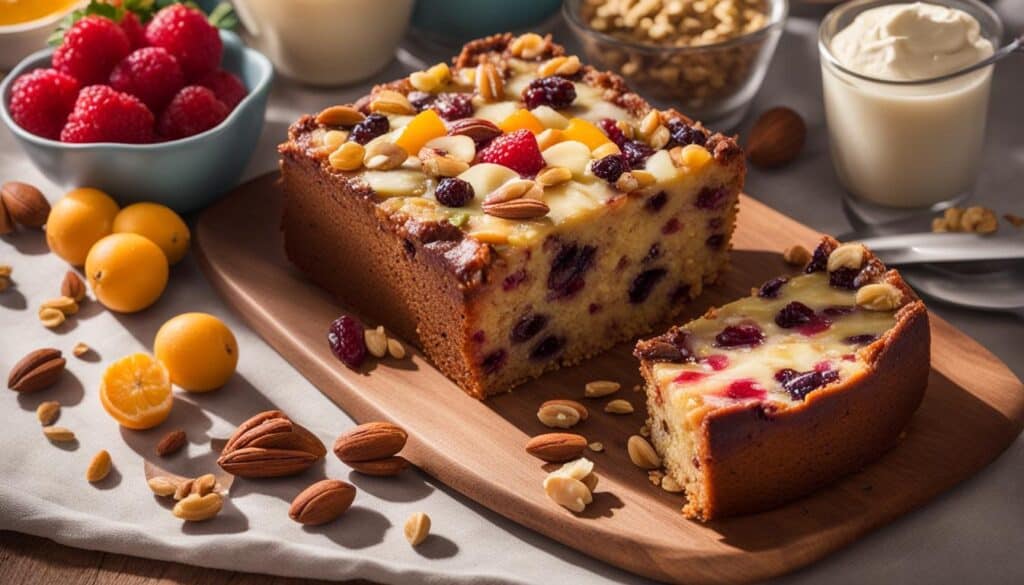
If you’re using larger nuts, like pecans or walnuts, try adding them as a decoration on top of the cake instead of mixing them into the batter. This way, they won’t have the chance to sink and will provide a beautiful, crunchy topping.
Now that you know how to prevent sinking fruits and nuts, you can confidently bake a fruit cake that looks as good as it tastes!
Dense or Poorly Combined Cake
Fruit cakes are known for their density, but when a cake becomes too dense, it can result in an unenjoyable and heavy texture. It’s important to ensure that all the ingredients are properly combined to create a fluffy and moist cake. Inconsistent temperatures, such as using cold eggs and butter, can hinder the mixing process and lead to a dense cake. To fix this issue and achieve a lighter texture, follow these steps:
- Bring all the ingredients, including eggs and butter, to room temperature before beginning the mixing process. This will allow the ingredients to blend together more easily and create a smoother batter.
- Use an electric mixer or stand mixer to thoroughly beat the butter and sugar together until light and fluffy. This step incorporates air into the batter, contributing to a lighter texture.
- Add the dry ingredients gradually, alternating with the wet ingredients, in several additions. This ensures that all the ingredients are evenly distributed and reduces the risk of overmixing, which can lead to a dense cake.
- Do not overmix the batter. Overmixing activates the gluten in the flour, resulting in a tough and dense cake. Mix just until the ingredients are combined and no streaks of flour remain.
- Check the expiration date of the leavening agent, such as baking powder or baking soda, used in the recipe. Expired leavening agents may not provide the necessary lift and could contribute to a cake that doesn’t rise properly.
By following these tips and ensuring proper ingredient combination and temperature, you can fix a dense fruit cake and achieve a moist and fluffy texture.
| Problem | Solution |
|---|---|
| Dense cake | Bring ingredients to room temperature, beat butter and sugar thoroughly, mix ingredients just until combined, check expiration date of leavening agent |
| Poorly combined ingredients | Ensure proper ingredient combination, use gradual additions of dry and wet ingredients, mix just until combined |
Hard Crust and Peaked Top
When baking a fruit cake, it’s important to achieve the perfect texture and appearance. One common issue that can occur is a hard crust with a peaked top. This can occur when the ingredients are overmixed, causing the gluten and protein fibers to tangle and create a tough texture.
To prevent this problem, it’s crucial to stop mixing as soon as the ingredients are fully combined. Overmixing can lead to a dense and compact cake, resulting in a hard crust. By gently folding the ingredients together until they are just incorporated, you can maintain a delicate and tender texture.
Remember, a fruit cake relies on the natural moisture of the ingredients, such as the fruits and nuts, to create a soft and moist texture. Overmixing can result in the loss of this moisture and lead to a drier cake with a hard crust.
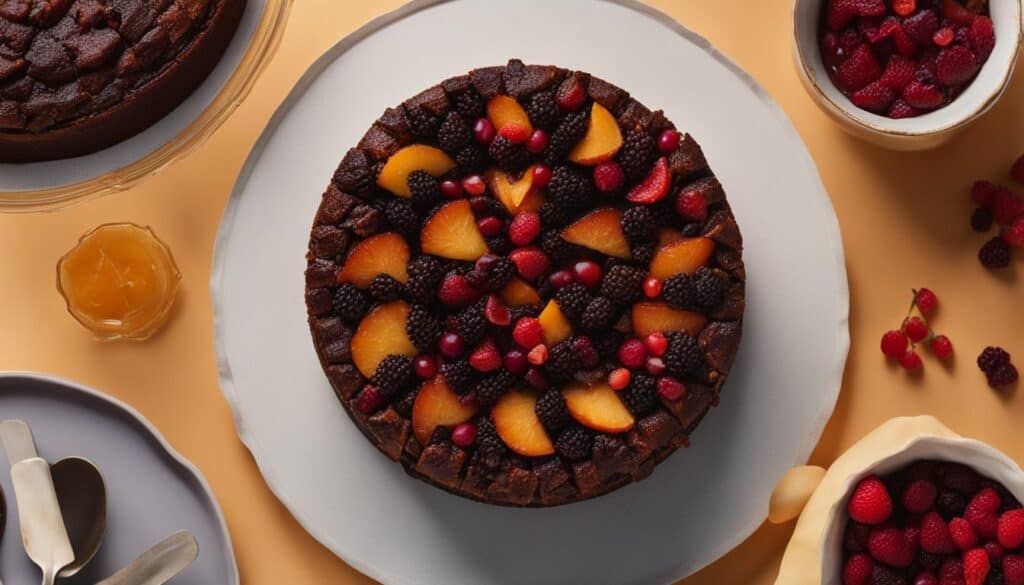
Preventing the Peak
In addition to the hard crust, a fruit cake may develop a peaked top during baking. This can be caused by various factors, including an uneven distribution of batter or an oven temperature that is too high.
To prevent a fruit cake from peaking, here are a few tips:
- Fill the cake pan no more than two-thirds full to allow for expansion during baking.
- Ensure the oven temperature is accurate and consistent throughout the baking process.
- Avoid opening the oven door frequently, as this can cause fluctuations in temperature and lead to uneven baking.
Following these tips will help you achieve a fruit cake with a perfectly even top and a tender, moist crumb.
Wet Middle or Bottom
If you find that the middle or bottom of your fruit cake is still wet after baking, don’t worry! There are simple steps you can take to fix this issue and ensure your cake is fully cooked.
Baking a fruit cake requires careful attention to both temperature and time. It’s possible that the cake just needs a little more time in the oven to fully cook the center and bottom.
After removing the cake from the oven, let it rest on a cooling rack for about 10 minutes. During this time, the residual heat will continue to cook the bottom and middle of the cake, helping it reach the desired consistency.
Remember to use a baking thermometer to check if the cake has reached the appropriate internal temperature. The center should read around 210°F (99°C) for a fully cooked fruit cake.
| Key Points: |
|---|
| Ensure the cake has enough time in the oven to fully cook the middle and bottom. |
| Let the cake rest on a cooling rack for about 10 minutes after baking to allow residual heat to finish cooking the center and bottom. |
| Use a baking thermometer to check if the cake has reached an internal temperature of around 210°F (99°C). |
By following these steps, you can fix a wet fruit cake and ensure that it is thoroughly cooked in the center and bottom. This will result in a moist and delicious cake that is ready to be enjoyed!
Tips for Fruit Cake Success
When it comes to baking a perfect fruit cake, it’s essential to pay attention to the details. By avoiding common mistakes and following these helpful tips, you can achieve fruit cake perfection.
1. Avoid opening the oven door too frequently: Opening the oven door during baking can cause fluctuations in temperature, leading to uneven baking and potential collapse. It’s best to resist the temptation to peek and allow your fruit cake to bake undisturbed.
2. Brush the cake with syrup when it comes out: To add moisture and enhance the flavor of your fruit cake, brush it with a syrup mixture immediately after removing it from the oven. This extra step will keep your cake moist and delicious.
3. Factor in the cake’s rise while filling the pan: Fruit cakes tend to rise and expand during baking, so it’s important to consider this when filling the cake pan. Fill the pan only two-thirds to three-quarters full to prevent overflow and ensure a well-formed shape.
4. Don’t skip the aging process: Unlike many other baked goods, fruit cakes benefit from an aging process. After baking, wrap your cake tightly in plastic wrap or aluminum foil and store it in a cool, dark place for several days to a few weeks. This allows the flavors to meld together and creates a richer, more flavorful fruit cake.
| Tips for Fruit Cake Success | |
|---|---|
| Avoid opening the oven door too frequently | ✔️ |
| Brush the cake with syrup when it comes out | ✔️ |
| Factor in the cake’s rise while filling the pan | ✔️ |
| Don’t skip the aging process | ✔️ |
Follow these tips to perfect your fruit cake and impress your friends and family with a delicious holiday treat. With careful attention to detail and a little bit of patience, you can create a fruit cake that is moist, flavorful, and absolutely delightful.
Importance of Measuring Ingredients
When it comes to baking, precision is key. The importance of measuring ingredients cannot be overstated, as it directly impacts the quality and taste of your baked goods, including fruit cakes. Incorrect measurements can lead to dry, crumbly, or flavorless cakes that fail to impress.
Precise measurement starts with using proper measuring tools. Invest in a good set of measuring cups and spoons, and consider adding a kitchen scale to your baking arsenal. Different ingredients have different densities, so relying solely on volume measurements may not always yield accurate results.
Consistency is another crucial element in measuring ingredients. In baking, ratios matter. Maintaining consistent proportions of ingredients ensures that you achieve the desired texture and flavor in your fruit cake. It’s not just about throwing in a handful of this or a pinch of that; precise measurements help maintain a balance of flavors and create a harmonious end result.
“Baking is both an art and a science, and accurate measurements are the key to success.”
Whether it’s the amount of flour, sugar, butter, or spices, each ingredient plays a specific role in creating the perfect fruit cake. Too much or too little of any ingredient can throw off the entire recipe, leading to undesirable outcomes. For instance, too much flour can result in a dry and dense cake, while too little sugar can result in a bland flavor profile.
By measuring your ingredients accurately, you take control of the baking process and set the stage for a delicious and well-balanced fruit cake. So next time you embark on a baking adventure, remember the importance of precise measurement and watch as your creations turn out consistently delightful.
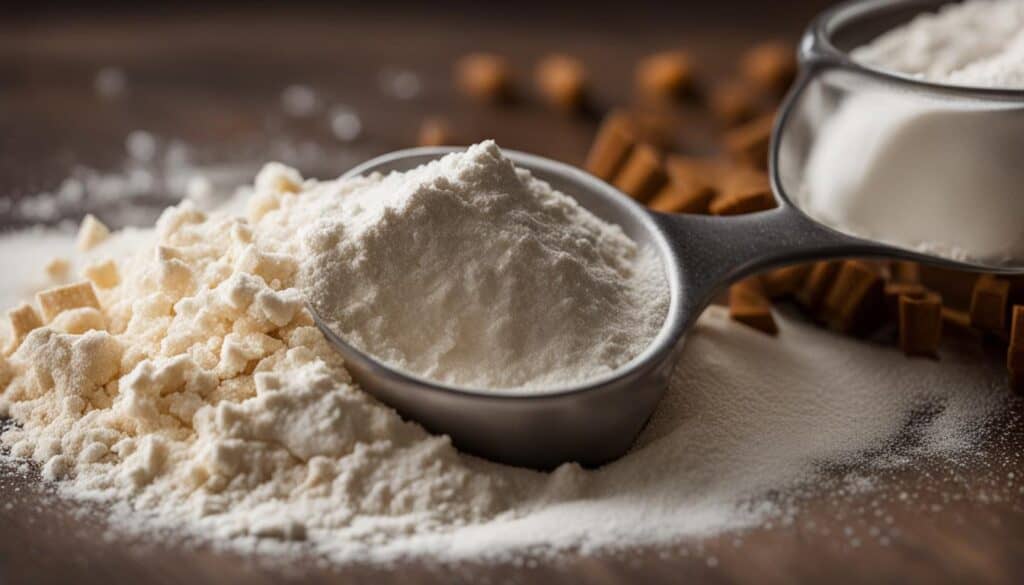
“Precision in measurement is the secret ingredient that elevates your baking from good to extraordinary.”
Maturation of Fruitcakes
Fruitcakes are known for their long shelf life, thanks to the high sugar and alcohol content that acts as a natural preservative. Understanding how to properly store and age your fruitcake is essential to enhance its flavor and ensure its longevity.
How long can a fruit cake last?
When stored correctly, a fruit cake can last for several months, or even up to a year. The exact shelf life may vary depending on the recipe and ingredients used. Fruit cakes that contain a higher alcohol content tend to last longer than those without.
“Proper storage and aging are key to a flavorful fruitcake.”
Fruit cake shelf life
To maximize the shelf life of your fruitcake, follow these tips:
- Wrap the fruitcake tightly in plastic wrap or aluminum foil to keep it fresh and prevent it from drying out.
- Store the wrapped fruitcake in an airtight container or tin to protect it from moisture and maintain its texture.
- Place the container in a cool, dry place, such as a pantry or cupboard, away from direct sunlight and heat sources.
- Avoid storing the fruitcake in the refrigerator, as it can alter the texture and moisture level.
- Periodically check the fruitcake for any signs of spoilage, such as mold or an off odor. If any signs are present, discard the cake immediately.
By following these guidelines, you can enjoy your fruitcake for an extended period, savoring its rich flavors throughout the year.
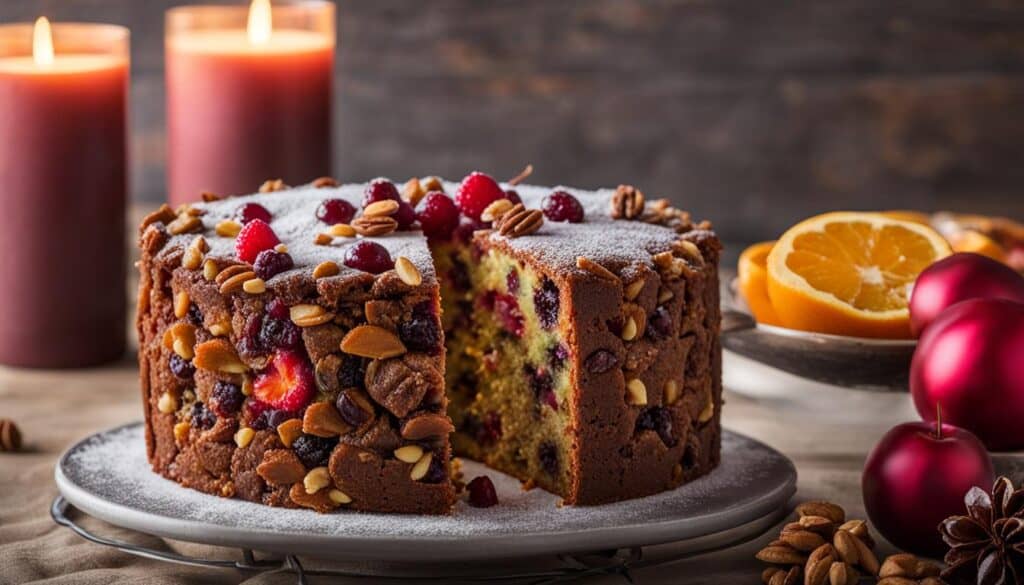
| Storage Method | Shelf Life |
|---|---|
| Wrapped in plastic wrap or aluminum foil, stored in an airtight container in a cool, dry place | Up to 6 months |
| Wrapped in plastic wrap or aluminum foil, stored in an airtight container in the refrigerator | Around 1 year |
| Frozen | Up to 1 year |
Note: These are general guidelines, and the actual shelf life may vary depending on the individual recipe and storage conditions.
Fruitcake Traditions and Variations
Fruitcake holds a special place in holiday traditions and is often exchanged as a heartfelt gift. This delectable dessert has diverse variations across different cultures and regions, each with unique flavors and preparation methods. Let’s explore some of the fascinating fruit cake traditions and variations:
1. Christmas Pudding
In the United Kingdom, Christmas pudding takes center stage during the festive season. This rich and moist fruit cake is typically made with suet, breadcrumbs, and a mix of dried fruits, spices, and alcohol. It is often steamed or boiled and served with a lavish pouring of warm brandy butter or custard.
2. Panettone
Hailing from Italy, panettone is a sweet bread loaf filled with candied fruits and nuts. This airy and fluffy cake is enjoyed during Christmas and New Year’s celebrations. The secret to its light texture lies in its slow and careful rise, resulting in a deceivingly light loaf that bursts with fruity flavors.
3. Black Cake
In the Caribbean, particularly in countries like Jamaica and Trinidad, black cake is a beloved treat. This dense and boozy fruit cake is made using chopped, soaked fruits like raisins, currants, and prunes, which are then blended with aromatic spices, rum, and sometimes molasses. The cake is baked low and slow to achieve its signature dark color.
4. Stollen
Originating from Germany, stollen is a festive fruit cake enriched with butter, almonds, and an assortment of dried fruits. Traditionally enjoyed during Christmas, this bread-like cake is often dusted with powdered sugar and has a subtly spiced flavor. Stollen is a symbol of good fortune and is often shaped into a long loaf to mimic the swaddled baby Jesus.
5. Bolo Rei
Bolo Rei, meaning “King Cake” in Portuguese, is a traditional Christmas cake eaten in Portugal. This ring-shaped fruit cake is studded with candied fruits and nuts, and sometimes filled with sweet creams or even a surprise gift. It is usually topped with powdered sugar and makes for a stunning centerpiece on the holiday table.
These are just a few examples of the many fruit cake traditions and variations around the world. Each culture brings its own unique spin to this classic dessert, inviting us to savor the diversity of flavors and customs that make fruit cake an integral part of festive celebrations.
| Culture | Fruit Cake Variation | Description |
|---|---|---|
| United Kingdom | Christmas Pudding | A rich fruit cake made with suet, breadcrumbs, and an assortment of dried fruits. |
| Italy | Panettone | A sweet bread loaf filled with candied fruits and nuts, enjoyed during Christmas and New Year’s. |
| Caribbean | Black Cake | A dense fruit cake made with soaked fruits, aromatic spices, rum, and sometimes molasses. |
| Germany | Stollen | A buttery fruit cake with almonds, dried fruits, and powdered sugar, often enjoyed during Christmas. |
| Portugal | Bolo Rei | A ring-shaped fruit cake studded with candied fruits, nuts, and sometimes filled with creams or a surprise gift. |
Conclusion
Baking a perfect fruit cake requires attention to detail, proper measuring, and the use of high-quality ingredients. By addressing common issues and following tips and techniques, you can avoid fruit cake problems and achieve a delicious and beautifully baked fruit cake.
When troubleshooting a fruit cake, it is important to consider factors such as dryness, crumbliness, density, sinking fruits, and improper cooking. To fix these issues, use proper measuring tools, such as kitchen scales and measuring cups, to ensure accurate measurements. Additionally, consider the quality of ingredients used and opt for high-quality options, such as brown sugar, butter with higher milk fat content, and locally picked and dried fruits.
Pre-soaking dried fruits, cutting larger fruit chunks into smaller pieces, and coating fruits and nuts with flour can prevent them from sinking in the cake and enhance texture. To achieve a fluffy cake, ensure all ingredients are combined properly by using room temperature ingredients and checking the expiration date of leavening agents. Avoid overmixing, opening the oven door too frequently, and skipping the aging process for optimum results.
In conclusion, with proper troubleshooting techniques and attention to detail, you can overcome fruit cake challenges and create a delectable treat for any occasion. Remember to follow the tips and recommendations provided in this guide and enjoy the satisfaction of a perfectly baked fruit cake.
FAQ
How can I fix a dry fruit cake that lacks moisture?
To fix a dry fruit cake, make sure you are using high-quality ingredients and proper measuring tools. Soak the dried fruits overnight in water, juice, or liquor to make them plump and juicy. Adjust the units in the recipe to ensure consistency.
What should I do if my fruit cake is dry and chunky?
Soak the dried fruits overnight in water, juice, or liquor to prevent them from becoming dry and chunky in the cake. Longer soaking, up to 4 to 6 weeks, can make the fruits extra plump and juicy.
How can I prevent fruits and nuts from sinking in the fruit cake?
Cut larger fruit chunks into smaller pieces and coat them with a thin layer of flour before mixing them into the batter. This will help the fruits and nuts stay in place and prevent their juices from seeping into the batter.
How can I fix a dense fruit cake that does not rise properly?
Make sure all the ingredients are combined in a homogenous emulsion. Warm up the ingredients, such as eggs and butter, to room temperature before mixing. Check the expiration date of the leavening agent used in the cake.
How can I prevent my fruit cake from having a hard crust and a peaked top?
Stop mixing as soon as the ingredients are fully combined to prevent the gluten and protein fibers from tangling and creating a tough texture. Ensure the ingredients are properly proportioned.
My fruit cake is wet in the middle or bottom, what can I do?
If the middle or bottom of the fruit cake is still wet, it simply needs more time in the oven. Baking fruit cakes requires attention to both temperature and time. Let the cake rest on a cooling rack for 10 minutes after taking it out of the oven to allow the bottom and middle to cook with the residual heat.
What are some tips for baking a delicious fruit cake?
Avoid opening the oven door too frequently, brush the cake with syrup when it comes out, factor in the cake’s rise while filling the pan, and do not skip the aging process. These tips will greatly improve your fruit cake.
Why is it important to measure ingredients accurately when baking a fruit cake?
Incorrectly measuring ingredients can negatively affect the quality of baked goods, including fruit cake. Precise measuring, using proper measuring tools, and keeping the proportions consistent are key to achieving the desired texture and flavor in a fruit cake.
How long does a fruit cake typically last?
Fruitcakes have a long shelf life due to their high sugar and alcohol content, which act as preservatives. Proper storage, such as wrapping the cake in plastic wrap or aluminum foil, and aging the cake for a few days to a few weeks can enhance its flavor.
Are there different variations of fruit cake?
Yes, fruit cake has various cultural variations such as Christmas pudding in the UK and panettone in Italy. Different regions and cultures have their own unique twists on this traditional dessert.

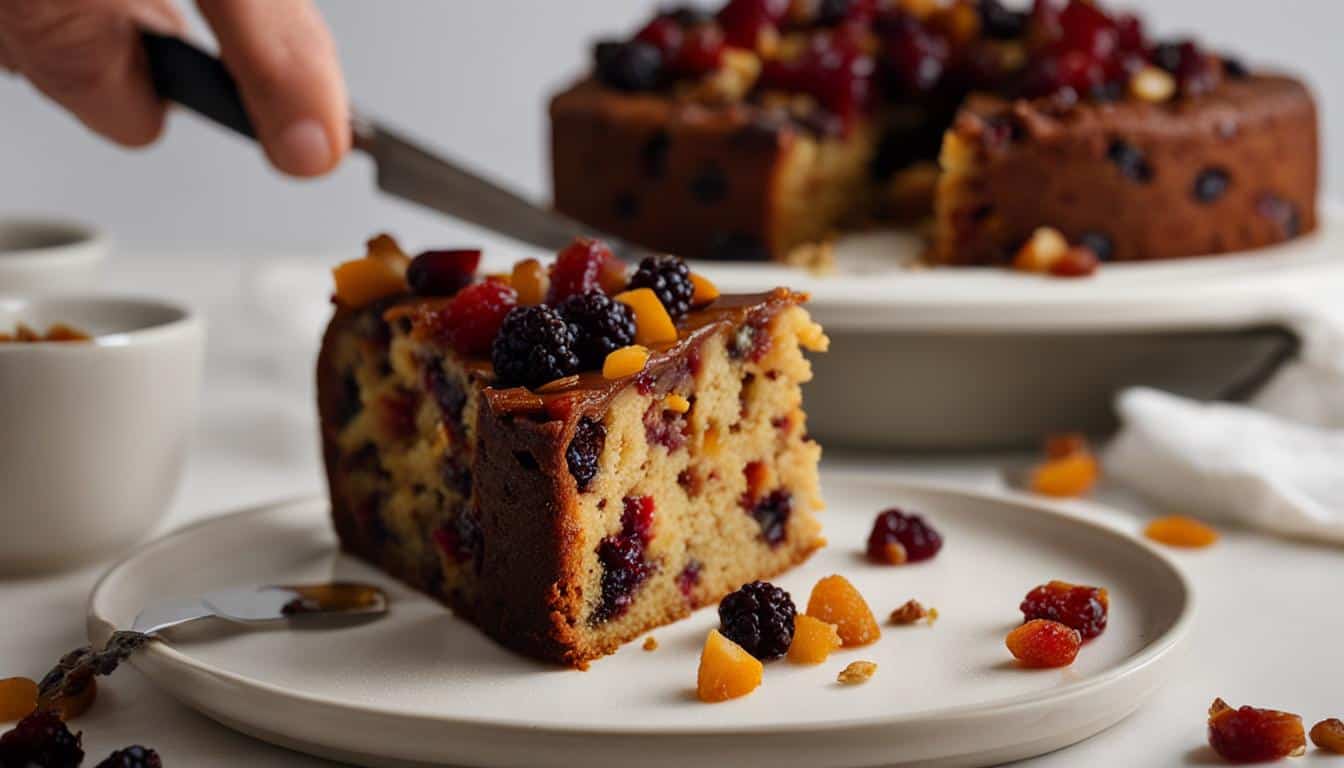



Leave a Reply